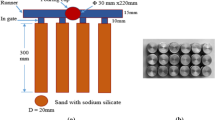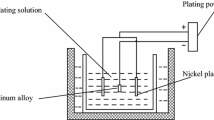Abstract
In this work, Ti6Al4V alloy was clad on commercially pure magnesium substrate by laser cladding. The laser cladding parameters were laser scan speed and powder feed rate. Wear behaviors of the clad substrates were evaluated by a dry sliding wear testing on Ti-6Al-4V counter material by pin-on-disc method. The wear testing parameters like applied load and sliding velocity were varied by keeping sliding distance as constant. The experimental data were used to develop an optimized neural network model. Network models predicted that the clad deposition affects the wear behavior. The combination of lower laser scan and highest powder feed yields higher deposition compared to higher laser scan and lowest powder feed combination. The higher material deposition improves the wear resistance of the substrates. The experimental data confirms the network models prediction by showing the lower wear rate at 200 mm/min–10 g/min laser parametric condition which has higher clad deposition than lower wear rate at 300 mm/min–5 g/min condition with lower materials deposition. Overall, laser cladding of Ti6Al4V on commercially pure magnesium improves the wear resistance by ~75%.
Access this chapter
Tax calculation will be finalised at checkout
Purchases are for personal use only
Similar content being viewed by others
References
Pommiers S, Frayret J, Castetbon A, Potin-Gautier M (2014) Alternative conversion coatings to chromate for the protection of magnesium alloys. Corros Sci 84:135–146.3
Gray JE, Luan B (2002) Protective coatings on magnesium and its alloys—a critical review. J Alloy Compd 336:88–113
Yong Z, Zhu J, Qiu C, Liu Y (2008) Molybdate/phosphate composite conversion coating on magnesium alloy surface for corrosion protection. Appl Surf Sci 255:1672–1680
Hornberger H, Virtanen S, Boccaccini AR (2012) Biomedical coatings on magnesium alloys—a review. Acta Biomater 8:2442–2455
Zhong C, Liu F, Wu Y, Le J, Liu L, He M, Zhu J, Hu W (2012) Protective diffusion coatings on magnesium alloys: a review of recent developments. J Alloy Compd 520:11–21
Song W, Martin HJ, Hicks A, Seely D, Walton CA, Lawrimore WB II et al (2014) Corrosion behaviour of extruded AM30 magnesium alloy under salt-spray and immersion environments. Corros Sci 78:353–368
Asmussen RM, Jakupi P, Danaie M, Botton GA, Shoesmith DW (2013) Tracking the corrosion of magnesium sand cast AM50 alloy in chloride environments. Corros Sci 75:114–122
Yu L, Cao J, Cheng YL (2015) An improvement of the wear and corrosion resistances of AZ31 magnesium alloy by plasma electrolytic oxidation in asilicate–hexametaphosphate electrolyte with the suspension of SiC nanoparticles. Surf Coat Technol 276:266–278
Hussein RO, Northwood DO, Su JF, Nie X (2013) A study of the interactive effects of hybrid current modes on the tribological properties of a PEO (plasma electrolytic oxidation) coated AM60B Mg-alloy. Surf Coat Technol 215:421–430
Riquelme A, Rodrigo P, Escalera-Rodríguez MD, Rams J (2016) Analysis and optimization of process parameters in Al–SiCp laser cladding. Opt Lasers Eng 78:165–173
Zhong M, Liu W (2010) Laser surface cladding: the state of the art and challenges. Proc Inst Mech Eng C: J Mech Eng Sci 224(5):1041–1060
Jones SP, Jansen R, Fusaro RL (1997) Preliminary investigation of neural network techniques to predict tribological properties. Tribol Trans 40:312–320
Çetinel H, Öztürk H, Çelik E, Karlık B (2006) Artificial neural network-based prediction technique for wear loss quantities in Mo coatings. Wear 261(10):1064–1068
Acknowledgements
This project is funded by the Science and Engineering Research Board (SERB), a statutory body of Department of Science and Technology (DST), Government of India under National Post-Doctoral Fellowship scheme (File No: PDF/2017/000412). The authors gratefully acknowledge the financial support by the DST-SERB, Government of India for this research work.
Author information
Authors and Affiliations
Corresponding author
Editor information
Editors and Affiliations
Rights and permissions
Copyright information
© 2023 The Author(s), under exclusive license to Springer Nature Singapore Pte Ltd.
About this paper
Cite this paper
Kannan, G.B., Revathi, S., Rajkumar, K., Duraiselvam, M. (2023). Network Topology Model for Wear Behavior Prediction of Ti6Al4V Clad Magnesium Substrates. In: Maurya, A., Srivastava, A.K., Jha, P.K., Pandey, S.M. (eds) Recent Trends in Mechanical Engineering. Lecture Notes in Mechanical Engineering. Springer, Singapore. https://doi.org/10.1007/978-981-19-7709-1_82
Download citation
DOI: https://doi.org/10.1007/978-981-19-7709-1_82
Published:
Publisher Name: Springer, Singapore
Print ISBN: 978-981-19-7708-4
Online ISBN: 978-981-19-7709-1
eBook Packages: EngineeringEngineering (R0)




